
Source: Lei Technology AI Hardware Group | Editor: Winter Jam | Typesetting: Autumn
As a flagship mobile chip, MediaTek’s Dimensity 9300, released at the end of last year, has made a remarkable comeback.
Not only the vivo X100 series, OPPO Find X7, and the upcoming Redmi K70 Supreme Edition are using the Dimensity 9300, but in energy efficiency tests and real-world experiences, it is also on par with the Snapdragon 8 Gen 3 and Apple A17 Pro.
From MediaTek’s perspective, a crucial factor is the “full large core design.” It seems that in the next generation of flagship chips, MediaTek intends to continue with the “full large core design.”
According to well-known leaker @Digital Chat Station, this year, the Dimensity 9400 will utilize ARM’s latest CPU architecture, codenamed “BlackHawk,” and the Cortex-X5 super large core has shown an IPC (instructions per clock) greater than that of the Apple A17 Pro in internal validation.
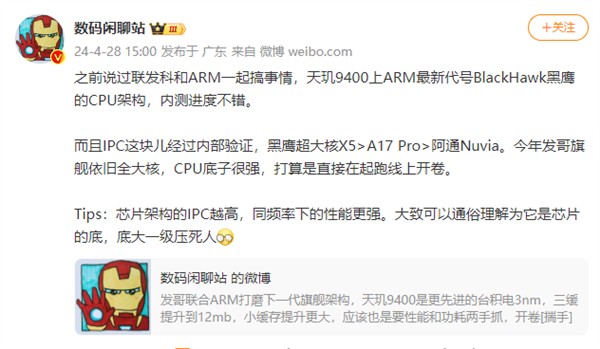
Image/Weibo @Digital Chat Station
IPC is one of the key indicators for measuring chip performance; the higher the IPC at the same frequency, the stronger the performance.
He also pointed out that the Dimensity 9400 will continue the full large core strategy, completely eliminating the traditional “small cores.”
However, the trend towards large cores is not limited to MediaTek; Qualcomm has also been strengthening the weight of “large cores” in its last two generations, not to mention that Apple has always prioritized “large cores.”
But why are both MediaTek and Qualcomm starting to follow Apple’s emphasis on large cores?

Qualcomm and MediaTek Move Towards Large Core Design
Since its launch, Qualcomm’s latest flagship chip, the Snapdragon 8 Gen 3, has received widespread acclaim, not only for its GPU performance but also for its CPU performance and energy efficiency, which have fully caught up with the Apple A17 Pro.
In terms of architectural design, Qualcomm has made significant adjustments. Following the previous generation Snapdragon 8 Gen 2, which increased large cores and reduced small cores, the Snapdragon 8 Gen 3 continues to increase the number of large cores to 5 while reducing the number of small cores to 2, forming a “1+5+2” tri-cluster architecture.
In terms of frequency, the Cortex-X4 super large core has a main frequency of 3.3GHz, while the 5 Cortex-A720 large cores are divided into two groups of “3+2” with main frequencies of 3.2GHz and 3.0GHz, respectively, along with 2 small cores with a frequency of 2.3GHz.
MediaTek is even more “aggressive,” directly announcing the “beginning of the full large core computing era.”
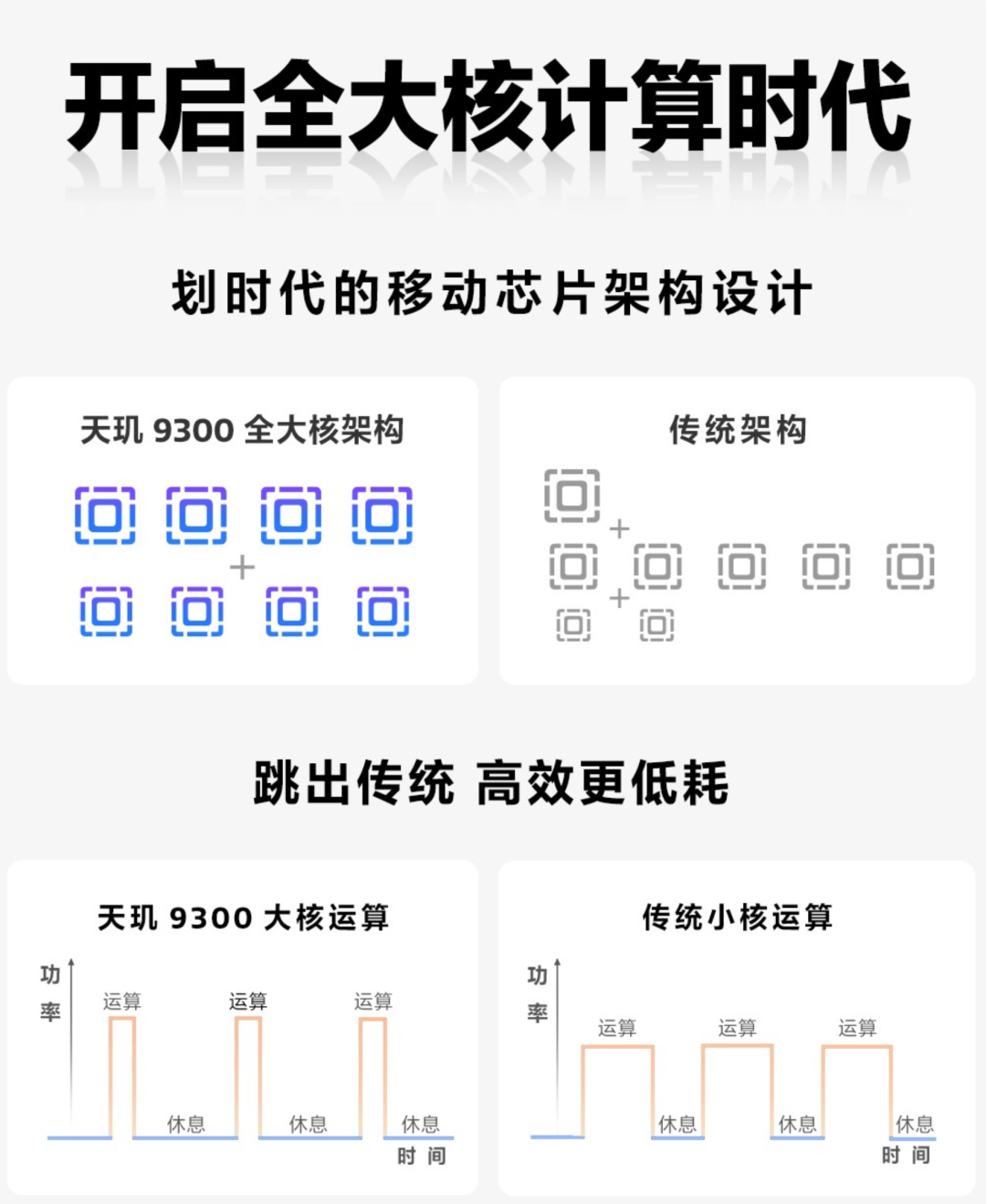
Image/MediaTek
In the CPU section, the Dimensity 9300 is also equipped with 8 cores, but it does not use any small cores; instead, it consists of 4 Cortex-X4 super large cores and 4 Cortex-A720 large cores.
Compared to the Snapdragon 8 Gen 3, the Dimensity 9300 appears very aggressive at first glance. Before its official release, there were concerns about its power consumption performance being “explosive.” However, after the actual unveiling, it became clear what MediaTek’s true intentions were.
First, the 4 Cortex-X4 super large cores of the Dimensity 9300 are actually divided into two groups. One has a frequency of 3.25GHz, which is roughly comparable to the Snapdragon 8 Gen 3. The other 3 have a frequency of 2.85GHz, which is even lower than the large cores of the Snapdragon 8 Gen 3.
Secondly, the 4 Cortex-A720 large cores of the Dimensity 9300 are all limited to 2.0GHz, which is also lower than the small cores of the Snapdragon 8 Gen 3.
So, in a sense, the Dimensity 9300 superficially adopts a “4+4” dual-cluster architecture, but is actually closer to the traditional “1+3+4” tri-cluster architecture.
This is not a case of “standing still.”
It is important to note that super large cores are significantly more efficient than large cores, far exceeding small cores. In other words, using super large cores to run large core frequencies and large cores to run small core frequencies not only improves performance but also enhances efficiency and energy efficiency.
In fact, the energy efficiency curve measured by Geek Bay shows that the Dimensity 9300 is far ahead compared to its predecessor, the Dimensity 9200.
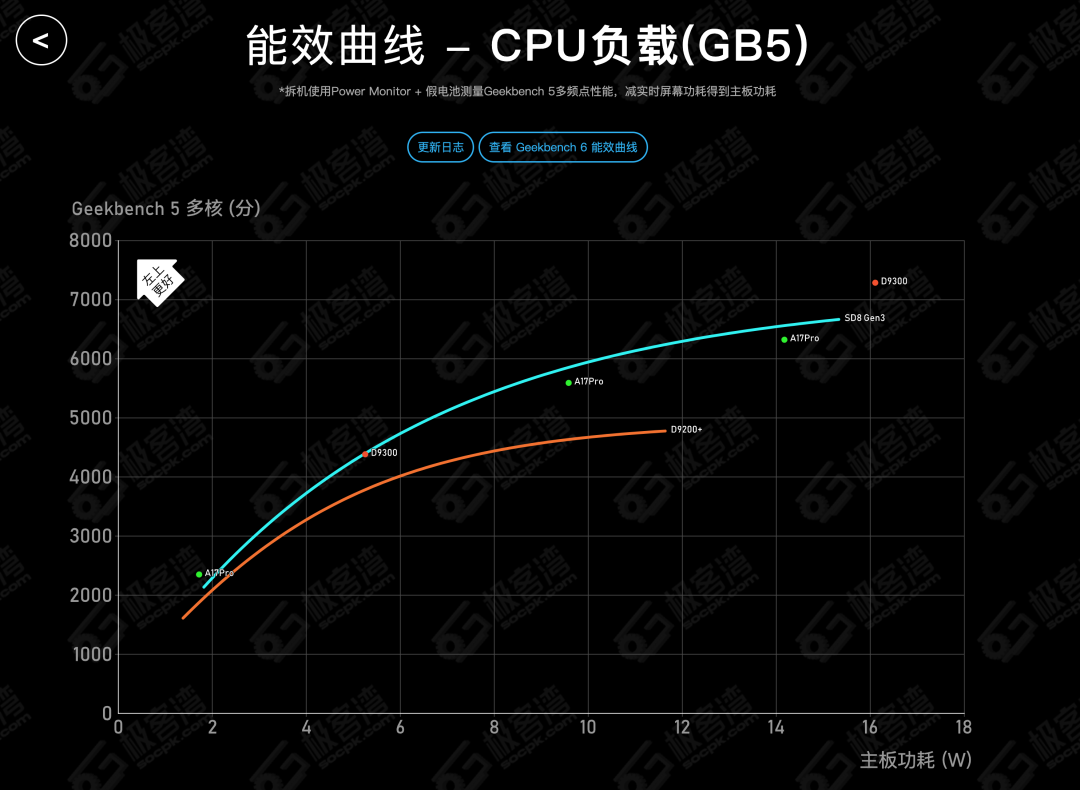
Image/Geek Bay
However, a few years ago, we might have found it hard to imagine such a change.

Apple: Large Cores Are Better
Many mobile enthusiasts may still remember that in 2016, MediaTek launched the Helio X20 deca-core processor, which consisted of 2 2.5GHz Cortex-A72 large cores, 4 2.0GHz Cortex-A53 small cores, and 4 1.4GHz A53 small cores.
However, the increase in core count of the Helio X20 did not lead to an actual improvement in experience; instead, it suffered from power consumption and heat issues caused by too many low-efficiency small cores, with only a few cores actually participating in “work,” easily leading to phone stuttering.
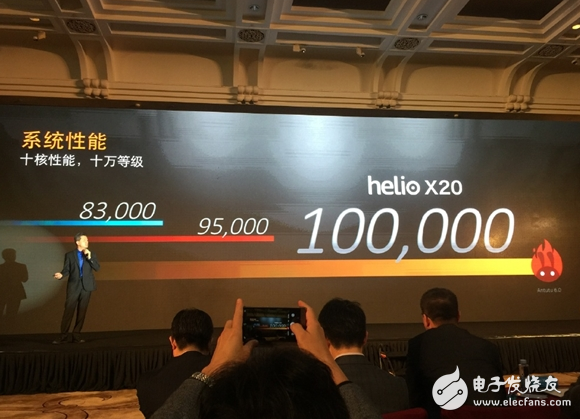
Image/Electronic Enthusiast
In contrast, Qualcomm’s Snapdragon 835 launched at that time received much better reviews. It adopted an octa-core design, with both large and small cores based on the Kryo280 architecture, featuring 4 large cores at 2.45GHz and 4 small cores at 1.9GHz, eliminating the need for “one dragging four.”
However, compared to Apple, Qualcomm was still “conservative.”
Unlike Qualcomm and MediaTek, Apple does not need to consider the opinions of “customers” and has always advocated a “few cores, large cores” approach. In 2016, Apple released the iPhone 7 series equipped with the A10 chip, marking the beginning of Apple’s transition from dual-core to quad-core.
However, unlike Qualcomm and MediaTek’s approach, the A10, although divided into 2 high-performance cores and 2 efficiency cores, actually has all four cores as large cores, identical in hardware, only differing in their performance orientation through an internal switch for high performance and low power consumption.
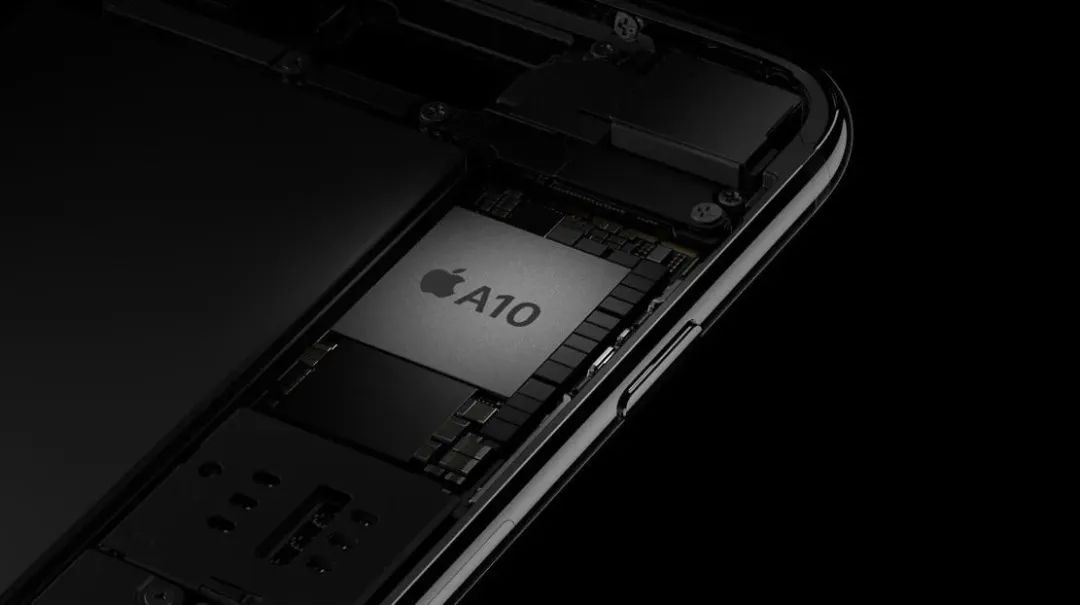
Image/Apple
This strategy reflects in practice, not only does the A10 lead in benchmark scores (especially in single-core performance), but more importantly, in actual mobile experience, the A10 exhibits stronger performance and smoother operation under high load, while also achieving higher efficiency and lower power consumption under low load. In short:
Stronger performance, and more energy-efficient.
Today, both the A16 and A17 Pro consist of 2 high-performance cores (P cores) and 4 efficiency cores (E cores), but in reality, Apple’s so-called E cores are closer to ARM’s large cores, while P cores even surpass ARM’s super large cores.
Thus, to some extent, the Dimensity 9300’s “full large core” design is aligning itself with Apple, and Qualcomm is also gradually moving in that direction.

What Has Changed from Small Cores to Large Cores?
In fact, whether in the past or present, from the perspective of daily use and CPU scheduling in games, large cores are often the core driving force. Under ARM’s big.LITTLE architecture, it is often promoted that small cores have low power consumption advantages in low-load scenarios.
However, in reality, rather than saying that small cores have low power consumption advantages in low-load scenarios, it is more accurate to say that small cores cannot handle medium to high loads, and are only somewhat useful under low loads.
Therefore, from an experiential perspective, eliminating small cores in mobile chips is an absolute advancement.
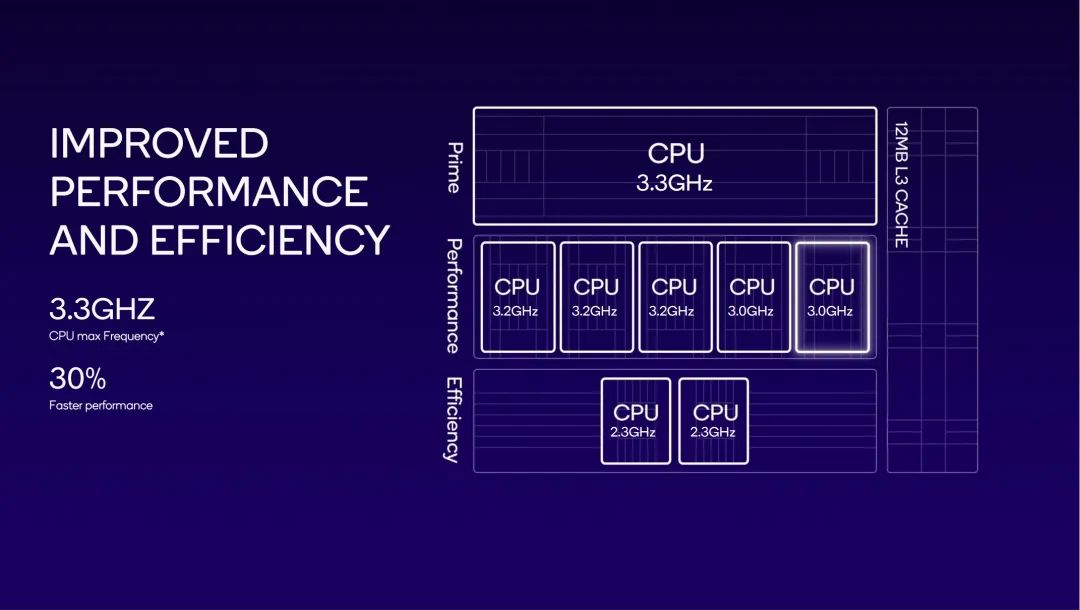
Image/Qualcomm
However, behind this, there may also be reasons related to the lack of product innovation and extreme competition in the mobile market, which is why we see the current trend of mobile manufacturers pushing the limits of screen curvature, brightness, and camera capabilities:
With product forms basically fixed, let’s push the existing experience to the extreme.
Smoothness is certainly an important aspect of this “pushing,” which forces both mobile manufacturers and chip manufacturers to continuously optimize the experience, from joint development to on-site customization.
Of course, the continuously rising prices of flagship devices also provide a foundation for the “full large core” design in mobile chips, as the Dimensity 9300 with a full large core configuration will undoubtedly be more expensive than the Dimensity 9200.
But regardless, for consumers, the trend towards large cores in mobile chips is a good thing. Chip manufacturers no longer need to overly consider the cost and marketing demands of mobile manufacturers, allowing for more reasonable and better architectural designs. At the same time, mobile manufacturers are gradually moving away from the obsession with “benchmarking”:
Facing user experience more honestly.
End
In 2024, AI large models will accelerate their implementation, and automobiles will become a golden scene. The consensus in the industry is that “the second half is about intelligence.”
On April 25, the Beijing Auto Show became a watershed for new energy vehicles entering the second half, with intelligence as the absolute protagonist, domestic brands rising strongly, and entrepreneurs becoming the new car models, while fuel vehicles, joint venture vehicles, foreign brands, and functional vehicles have completely fallen out of favor.
During the auto show, Lei Technology’s new media outlet, focusing on electric vehicles and understanding intelligence, sent a luxury reporting team to Beijing, conducting systematic in-depth reporting, producing a total of 8 videos, 8 in-depth analyses, and a wealth of short content, garnering over a million views across the internet and achieving multiple WeChat articles with over 100,000 views (real traffic), attracting significant attention in the industry professional media.

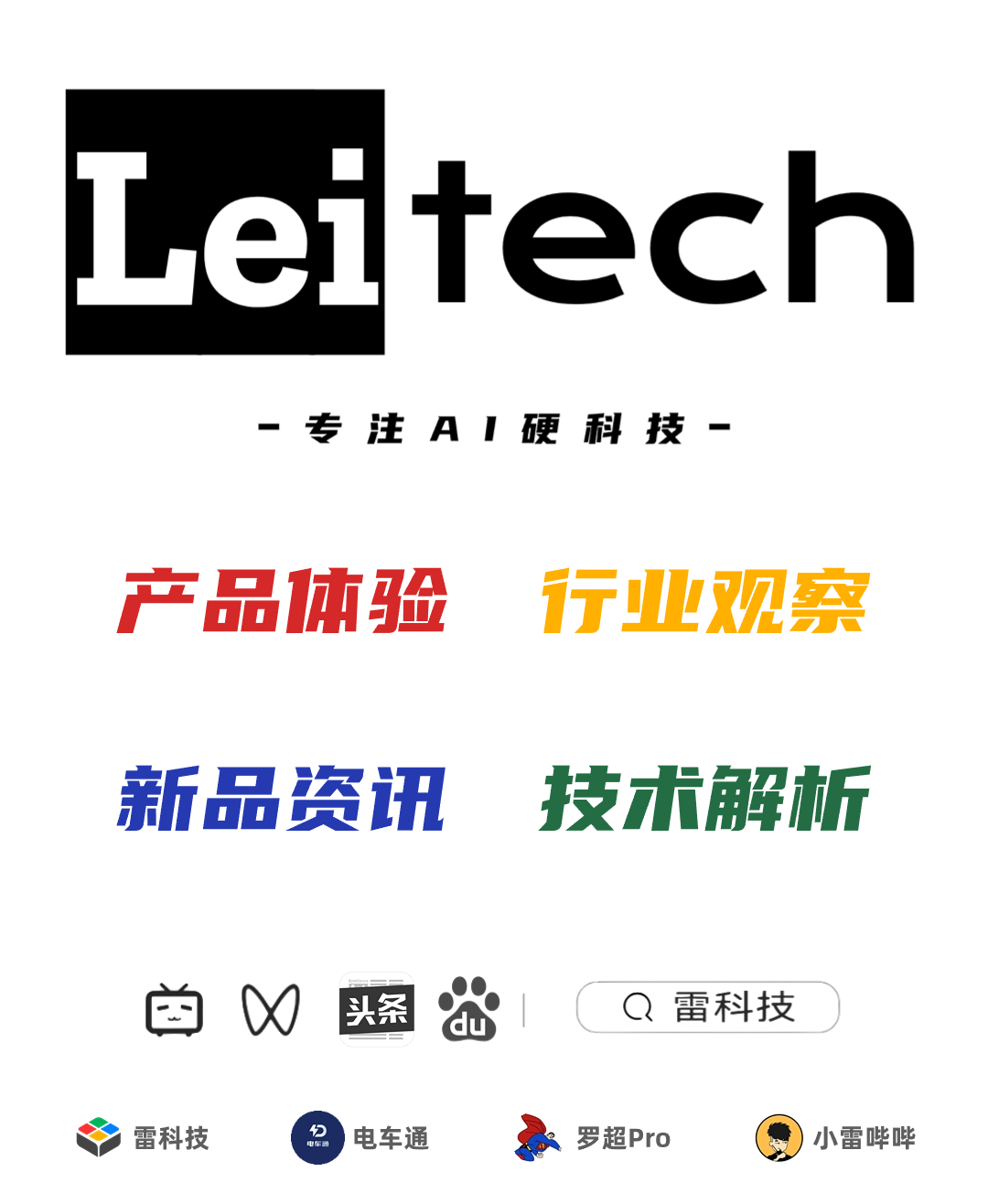

2024 Beijing Auto Show Special
1、2024 Beijing Auto Show New Car Preview: Some will create brilliance, while others will become a swan song?2、The biennial Beijing Auto Show will judge certain car companies based on intelligence.3、The “Five Giants” of domestic cars battle at the Beijing Auto Show: The first place is not surprising, but the last place is unexpected!
4、Lei Jun and his Xiaomi car “scared” competitors at the Beijing Auto Show | Video
5、At the Beijing Auto Show, Lei Jun becomes a legend
6、This auto show saw traditional car companies go from “stubborn” to “surrender”
7、The strongest domestic electric vehicles at this auto show are these | Video
8、Lei Jun collaborates with BYD’s Wang Chuanfu, plotting “modular cars”?
9、It’s one thing to be unable to compete, but these luxury brand new energy vehicles really tried hard | Video
10、This Beijing Auto Show is tough for joint venture brands
11、From watching new cars and car models to watching executives, Lei Jun has changed the flavor of the Beijing Auto Show
12、AI permeates the auto show, stealing the spotlight from Lei Jun | Video
13、At this auto show, new force car companies have turned “stupid technology” into a compliment
14、11 questions to restore the present and future of the Beijing Auto Show